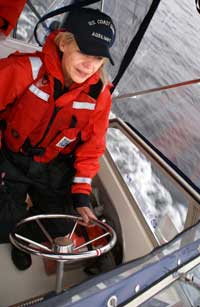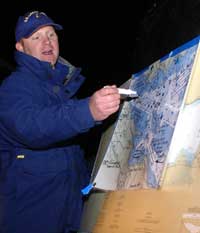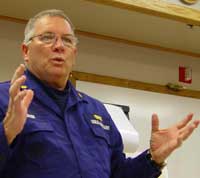'Mass Casualty' Search-and-Rescue Exercise on Oneida Lake
Sat, 05 Jan 13 Posted by: Robert Stronach
A 38-foot go-fast boat leaves a party on the north shore of Oneida Lake and speeds along at 67 miles per hour when it runs over a 16-foot aluminum runabout fishing boat on the west side of the lake near buoy 133. The collision demolishes the smaller boat and injures its five occupants. The go-fast boat sputters wildly out of control for almost a mile before breaking apart and tossing people out along the way. Two of the three people on board are seriously hurt and one is dead. A man, two women and a child who were on the fishing boat are in the water with severe injuries. Another child is fatally hurt.
Another boater calls Oswego County 9-1-1 operators who notify local first responders and the Coast Guard.
 Coxswain Deb Somers takes the helm of an Auxiliary facility that deployed dummy "victims" for the search-and-rescue exercise. |
“The goal is to recover eight persons,” Currier said at a pre-exercise briefing involving personnel from all five flotillas in Division 2.
Noted Machinski: “So many different departments work the lake…We’re working with fire departments to teach the basics of search patterns.” He said it involved building a cooperative working relationship, and, Currier added later, it’s part of an effort to reinvigorate the Oneida Lake SAR Council.
Marine units from Brewerton, Cleveland and West Monroe fire departments responded to the initial call at about 4:30 p.m. A Coast Guard 25-foot response boat from Station Oswego joined the search about 45 minutes later as well as Oneida County Sheriff’s marine patrol from the east side of 22-mile-long Oneida Lake.
With Machinski acting as incident commander, auxiliarists and agency liaisons staffed a command post at Trade-a-Yacht Marina where two mobile communications units were set up from Oswego and Oneida counties.
|
|
Auxiliarist controllers/evaluators (John Conroy, John Steinbarge, Dan Welch) accompanied the crews of the rescue boats.
Two auxiliary facilities from Brewerton Flotilla 2-14, sporting crews from multiple flotillas, were pre-positioned on the lake, one at the collision point, where the search would start, and the other along a line of “debris” and “bodies” in the water. The latter boat deployed six mannequin heads attached to life jackets and chemical lights. Each had a number corresponding to victims with specified injuries, which would help the rescue boats evaluate conditions before bringing victims ashore to meet imaginary EMS squads. In addition, the Coast Guard response boat deployed two life-size Oscar mannequins representing deceased victims. There were some 45 participants on the water and ashore, Currier noted, plus observers from Ithaca Fire Department, interested in doing an exercise with the Coast Guard Auxiliary on Cayuga Lake, and the NY State Police scuba diving team.
With two-thirds of the exercise conducted in the dark, and with deteriorating weather that included wind-whipped waves, falling temperatures, and periods of rain and sleet, Currier noted that the fire and law enforcement crews were able to recover five of the eight victims before the exercise was called. At least one of the other victims floated into shallow areas near shore. In a real incident, ground teams would join the search to find such victims.
 BM1 David Machinski points to chart of Oneida Lake during a "hotwash" debriefing immediately following the SAR exercise. |
It’s “a very effective way to capture important information when it’s fresh on people’s minds,” Currier said. Participants talked about their experiene and offered “some suggestions for further follow-up to improve operational performance.” He added: “Some participants noted they had no idea before the exercise how difficult it really is to function at night and run specific SAR patterns.”
It is important to note that the full scale exercise did not happen overnight, Currier said. It was the result of two years of collaborating with Oneida Lake first responders, building rapport, and conducting several orientation and tabletop exercises -- including an advanced tabletop exercise (TTX) last spring that led to the October exercise on the lake.
“The large advanced tabletop last spring blew us away with participation,” Currier said. “Over 50 people from local, county, state and federal agencies attended, representing law enforcement, fire, emergency management, 9-1-1 centers, the Coast Guard Auxiliary, the Coast Guard from Sector Buffalo, and three county fire coordinators’ offices. Based on our interim fact finding, we had prepared some unique ways of assessing certain skills, such as plotting and chart work, by building it into activities to support the scenario. Other similar embedded exercise activities got the groups to ‘self-identify’ many areas where they could use help or needed to improve their capabilites. So - building on the progressively more complex and difficult ‘building block’ approach to training exercises - the October full scale exercise was created using a very similar incident scenario.”
The exercise accomplished an essential goal -- getting multiple agencies to work together in a catastrophic scenario and discover what they need to address to do it better next time (everything from being able to communicate on the same marine radio channel to developing standard operating procedures for responding to incidents on Oneida Lake).
The good news is, Currier reported, “agencies who don’t typically train together found ways to integrate their respective knowledge, skills and experience into a workable search.”
